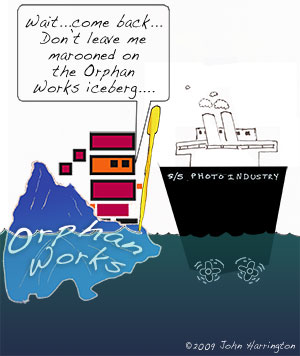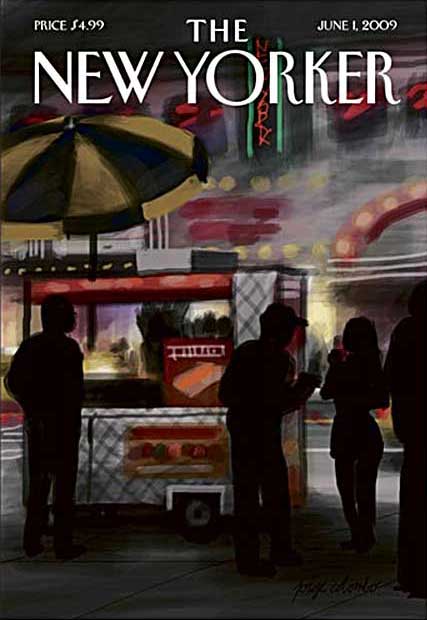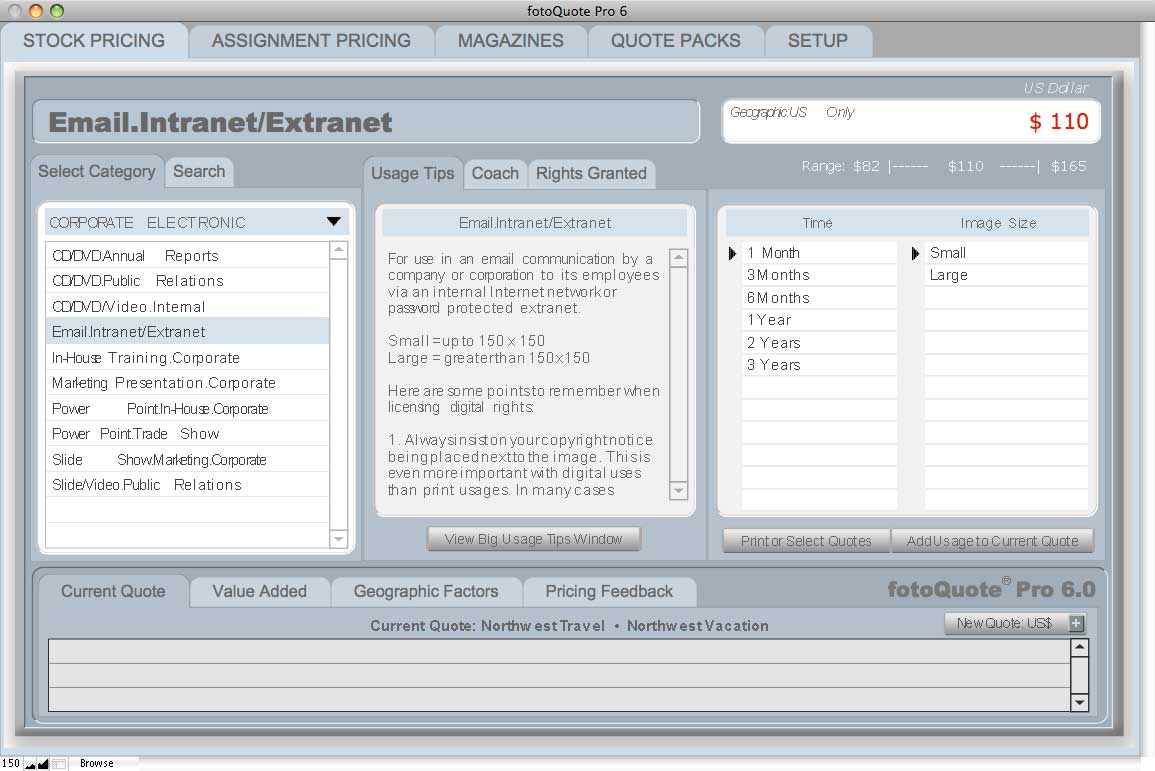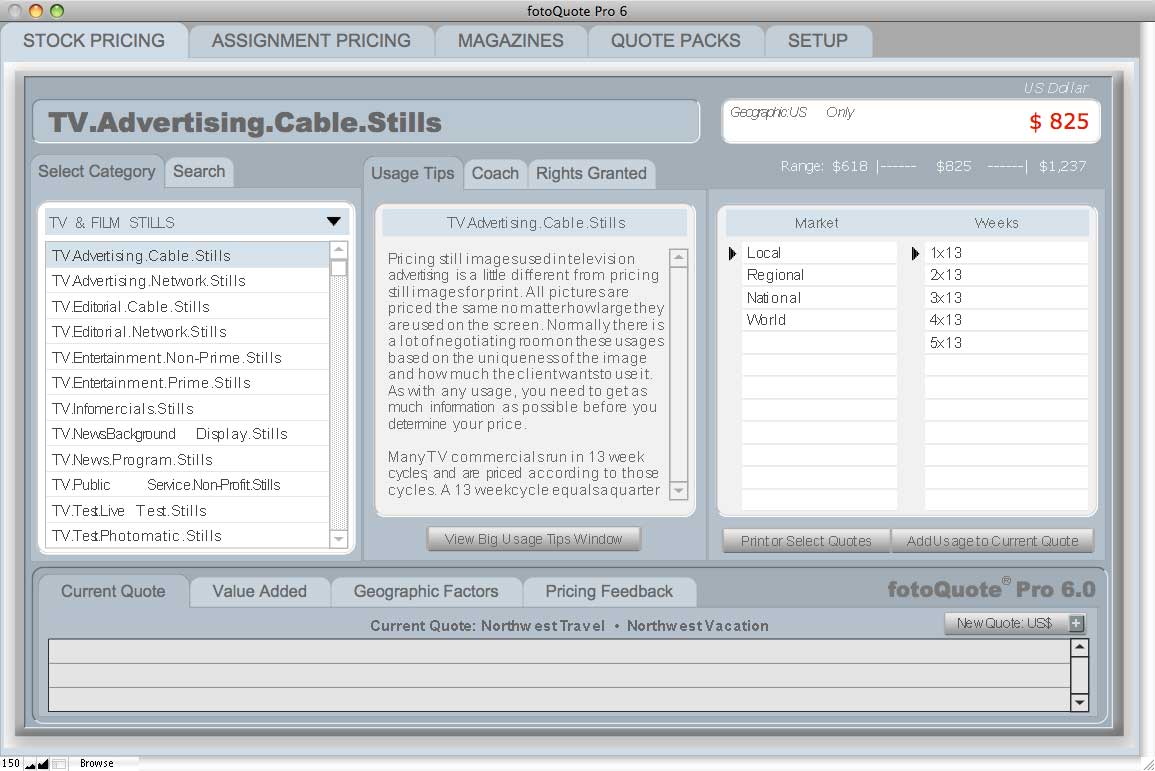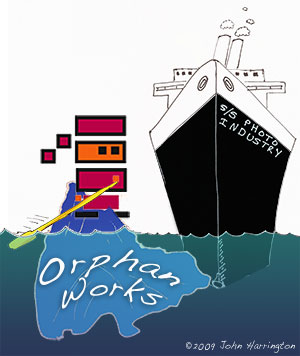 PicScout, one of several image search solutions, has been mis-informing people of late, and it's not sitting well with me. In their latest blog entry, dated May 25th, they have made several statements that are factually inaccurate at best, and misleading at a minimum.
PicScout, one of several image search solutions, has been mis-informing people of late, and it's not sitting well with me. In their latest blog entry, dated May 25th, they have made several statements that are factually inaccurate at best, and misleading at a minimum.
PicScout suggested:
if you don’t register your photos with the US copyright office, your claim against any infringer–with or without the OWA–would be based on calculations that are unaffected by OWA.
This statement is factually inaccurate. Whether or not you registered your images, you can file a Digital Millenium Copyright Act takedown claim and get someone to stop using them if you find out. Under past OWA proposals, you cannot prevent someone from continuing to use the image they found. OWA would severely affect copyright owners regardless of registration, or a desire for money. Further, there is a huge difference between the amount that the rights-holder and infringer would reasonably agree upon (as required in past version of the OWA) as compared to what a rights-holder could have reasonably requested. When an infinger can point to tens of thousands of images selling for $1, when I suggest that I would not have licensed the image that was infringed for less than $1,000, or even $250, my position will appear unreasonable, even were I to be able to point to a history of licensing at those levels.
(Continued after the Jump)
PicScout suggested:we start with the most specific item: the text of the bill says that if the publisher of the work has done a “diligent search,” then the OWA would provide protection from statutory damages in an infringement claim.
Here's the actual text from the House bill:"an award for monetary relief (including actual damages, statutory damages, costs, and attorney’s fees) may not be made other than an order requiring the infringer to pay reasonable compensation to the legal or beneficial owner of the exclusive right under the infringed copyright for the use of the infringed work."
In point-of-fact, the infringers protection would be much more than just statutory damages as previously proposed.
PicScout suggested:since only about 5% of pro photographers or stock photo agencies bother to register their works with the US copyright office, 95% of the photo industry would be almost entirely unaffected by OWA.
There is so much wrong with this statement -- it is so fundamentally inaccurate I don't know where to begin. Suppose you never registered your work, yet you licensed exclusivity to a client who published your work in an ad. Someone scanned that image in, and posted it on the internet, and someone else finds it and wants to use it for an ad. They do so, and you find out about it from an irrate client who thinks you licensed the image to their competition. You contact the infringer, only to find out that they couldn't find your image on a "diligent search", and as such, used it, and now, will pay you a nominal amount which you are required to take. Your acceptance of this income places you in contractual violation with the commissioning client, and they will sue you.'
Currently, whether or not a rights-holder has registered their work before an infringement occurs, the rights-holder may recieve actual damages, disgorged profits, and may force the infringer to halt the infringing activity. Actual damages include not only the fee that the owner could have reasonably required of the infringer, but also compensation for any other damge to the owner's ability to market the work. Many rights holders who have registered their work opt to forfeit statutory damages in favor of actual damages, which would have been an available remedy even if the owner had not registered the work.
Then there is the fact that the proposed OWA would allow anyone to use any image for any purpose, including purposes that are morally or commercially objectionable to the rights-holder, such as advertisements for certain causes, or usages that directly conflict with existing exclusive licenses issued by the rights-holder, or usages that will prevent the rights-holder from monetizing their image in the future. For example, an infringer could use an image on a book cover. This would immediately destroy the rights-holder's ability to license book cover use for that image, and the rights-holder would have no right to stop the infringing activity, even after it is discovered. This is very different from the pre-OWA world, in which every rights-holder is able to prevent and stop objectionable uses of their images.
PicScout suggested:But this confusion is because they are reading that line by itself. You can’t do that. It’s tied directly to a part of the bill that requires the copyright office to create a “certification process for the establishment of an electronic database to facilitate the search for pictorial … works that are subject to copyright protection under title 17, United States Code....there is only ONE such database!...Some have created a myth that there will be many registries and databases, each containing some subset of copyrighted works."
You're right PicScout, you can't pick and choose which lines you read, and which you ignore. H.R. 5889 includes this language:(a) ESTABLISHMENT OF DATABASE.— (1) IN GENERAL.—The Register of Copyrights shall undertake a certification process for the establishment of an electronic database to facilitate the search for pictorial, graphic, and sculptural works that are subject to copyright protection under title 17, United States Code.
S. 2913, which was approved by the Senate, had this language:SEC. 3. DATABASES OF PICTORIAL, GRAPHIC, AND SCULPTURAL WORKS.
The Register of Copyrights shall undertake a process to certify that there exist and are available databases that facilitate a user’s search for pictorial, graphic, and sculptural works that are subject to copyright protection under title 17, United States Code. The Register shall only certify that databases are available under this section if such databases are determined to be effective and not prohibitively expensive...
Thus, they are undertaking a "certification process" (House version), and "a process to certify" (Senate version), NOT establishing their own, and this has been stated;
HOUSE VERSION:(b) PUBLIC AVAILABILITY.—The Register of Copyrights— (1) shall make available to the public through the Internet a list of all electronic databases that are certified in accordance with this section; and (2) may include any database so certified in a statement of best practices established under section 514(b)(5)(B) of title 17, United States Code.
HOUSE VERSION:SEC. 4. EFFECTIVE DATE. (b) PICTORIAL, GRAPHIC, AND SCULPTURAL WORKS.—With respect to pictorial, graphic, and sculptural works, the amendments made by section 2 shall— (1) take effect on the earlier of—(A) the date on which the Copyright Office certifies under section 3 at least 2 separate and independent searchable, comprehensive, electronic databases, that allow for searches of copyrighted works that are pictorial, graphic, and sculptural works, and are available to the public through the Internet; or (B) January 1, 2013; and (2) apply to infringing uses that commence on or after that effective date.
SENATE VERSION:
(c) Effective Date- (1) IN GENERAL- The amendments made by this section shall--(A) take effect on the later of--
(i) January 1, 2009; or
(ii) the date which is the earlier of--
(I) 30 days after the date on which the Copyright Office publishes notice in the Federal Register that it has certified under section 3 that there exist and are available at least 2 separate and independent searchable, electronic databases, that allow for searches of copyrighted works that are pictorial, graphic, and sculptural works, and are available to the public; or
(II) January 1, 2013;
What part of that language in either the House or the Senate versions, that suggests there will be fewer than TWO? In point-of-fact, the bill would go into effect once " at least 2 separate and independent searchable, comprehensive, electronic databases" or, the "later of" the above (as cited from the Senate version). Let's highlight the word "at least", since PicScout seems to think that it is "a myth that there will be many registries and databases".
However, perhaps I, and everyone else I know who knows what they're talking about on this got it wrong, and PicScout got it right. So, we put the following questions to Maria Pallante, Associate Register, Policy and International Affairs, for the Copyright Office today, and she stipulates "our answers relate to the language that passed the Senate in 2008." (As you can see above, the language on this issue between the House and Senate versions is essentially identical.)
Q: Does the Copyright Office intend, or are they planning, to create, establish, run, or manage, either internally, or with oversight by any contractor, a single database to facilitate searches for pictorial images, in the event that Orphan Works legislation is enacted?
M.P.: "No."
Q: Does the Copyright Office intend to certify more than one electronic database for searches of copyrighted works that contain pictorial images?
M.P.: "we either have to certify two databases or no databases. In other words, the legislation either becomes effective by a date certain or it becomes effective earlier than the date certain because we have certified that the defined databases exist. The certification process is linked only to the effective date. It is not a separate or ongoing function."
That's pretty clear.
Thus, in order to make the legislation active prior to the start date they would have to certify a minimum of two, however, the Copyright Office could and likely will certify dozens or even hundreds of databases before the start date, not just two. Further, PicScout's assertion that "contractors that are selected will be paid to create the database itself, at which point, the Copyright Office will put it into operation (including populating it with content and administering it)" is misinformed - if we are to believe the Associate Register for Policy and International Affairs, and I would believe her over the hopes-stated-in-the-form-of-expectation from a potential contractor candidate like PicScout.
Further, the legislation does not place any caps on the number of databases that can be certified. So, if a bill passes the Senate (again) with the same, or similar language, these certified databases - databases that satisfy the requirements set forth by the Copyright Office - will be approved. Further, once certified, there is no language that requires that any particular database, or a set number of databases, must be included in a diligent search. Thus, an infringer would be able to pick and choose the databases that they wish to search as a part of a diligent search, resulting in rights-holders in effect having to register with every database, since they must, as the Senate legislation stipulated be "independent." Further, since the statutory requirement would be to have two, it would be reasonable, at least at the outset could include only those two databases. While there has been discussion of allowing trade associations and others to create "guidelines" for diligent search, these would at most be guidelines, not legal requirements for a diligent search.
Thus, with a high degree of likelihood, as the number of certified databases grow, infringers will search the least populated, most poorly designed - yet certified - databases to "complete" their diligent search, and thus be allowed to infringe with immunity under the OWA. Further, I have heard of plans for "themed" databases and databases pertaining only to certain categories of works. The Senate and House versions of the bill both allowed for infringements to begin after only two databases were approved, without any consideration as to whether those databases were photography, film, sculpture, painting, poetry, etc. So, for example, even if there were no approved photography databases, if a sculpture and film database were to be approved, the minimum quantity of 2 would be satisfied, and the infringement floodgates would open.
PicScout suggested:Relax. The bill doesn’t define a “diligent search” because it doesn’t need to: There is only one copyright database. You only need to search “the one.”
This is like the musicians playing on the deck of the Titanic - lulling people into a false sense that all will be okay. There will not be "only one", there will be "atleast two", and almost certainly dozens of certified databases.
PicScout suggested:The elephant in the middle of the room is, “Who’s going to index the copyright office’s database?” Since it’d be public, anyone could. And obviously, PicScout could.
Fortunately, the OW bill from last session includes this language:"...security measures that reasonably protect against unauthorized access to, or copying of, the information and content of the electronic database."
So, technically, if the Copyright Office had a database (which they state above they would not), then perhaps they might employ, say, a contractor to do it? Again, fortunately, when asked if that would be happening, they said "no." It seems, perhaps, that PicScout would like to be that contractor (the one that won't exist), and be awarded a contract that would grant them the right to index all of the content that might be in the hands of the Copyright Office?
Is it possible, that the Congress, or the Copyright Office, would require the company that was awarded that contract to be, say, American? That would certainly put PicScout, and Israeli company and Idee, a Canadian company out of the running. Digimarc is a possible solution and is US-headquartered, and Google, which currently has the ability to search for content by typing, say "bicycle" into a search and finding images with that in them, likely also has comparable (or better) image-matching capabilities they just need to flip the switch on, and they too, are not only US-headquartered, but they also have existing relationships with the Library of Congress, even being a presenter at a technology expo (across the room from PicScout) that took place on Capitol Hill a year or so ago. While this type of protectionist approach to being awarded the contract to index all of the CD's and DVD's (and analog content) that is in the hands of the Copyright Office isn't fair, it was done for the steel industry in the economic recovery act, and other examples abound.
PicScout Suggested:Once online, your photos can exist anywhere and everywhere in the whole big, fat, wide world. And if someone gets their hands on one, and wants to publish it in a way that would require paying you a license fee, the OWA would compel them to do a “diligent search,” which would instantly lead them directly to you - swoosh! Took all of one second....Big money comes your way.
I return to my previous quote:"an award for monetary relief (including actual damages, statutory damages, costs, and attorney’s fees) may not be made other than an order requiring the infringer to pay reasonable compensation to the legal or beneficial owner of the exclusive right under the infringed copyright for the use of the infringed work."
Where in there do you see "big money." In point-of-fact, "big money" and "reasonable compensation" are not even close to one another. In an era of $1 microstock, what judge is going to award much more than that, when the infringer can point to tens of thousands of images available for unlimited use for $1. This, even when that rights-holder could demonstrate that typically license similar uses for $10,000. The OWA contained no mechanism for arriving at the reasonable compensation. As such, you can expect a deadlock in almost every instance, and if the infringer delivers what they believe to be a reasonable payment, the infringer wins because the owner is prevented by law and by circumstance from pursuing the infringement.
Further, PicScout, you left out the part where you are responsible for posting all of your images into these databases if they are not registered - in effect, having to "re-register" your images a second time for ALL your past registrations.
PicScout is supposed to be looking out for photographers, and previously, it seemed that they were putting their great technology to use for good. This blog post, full of misinformation about Orphan Works gives every indication that PicScout has re-charted their course into dangerous waters, and they are now intent upon lulling photographers into believing that the previous versions of Orphan Works bills would have been good for them. This is an unfortunate change of strategy at PicScout, and will harm, rather than help, individual photographers and the photography industry at large.
Please post your comments by clicking the link below. If you've got questions, please pose them in our Photo Business Forum Flickr Group Discussion Threads.
[More: Full Post and Comments]
